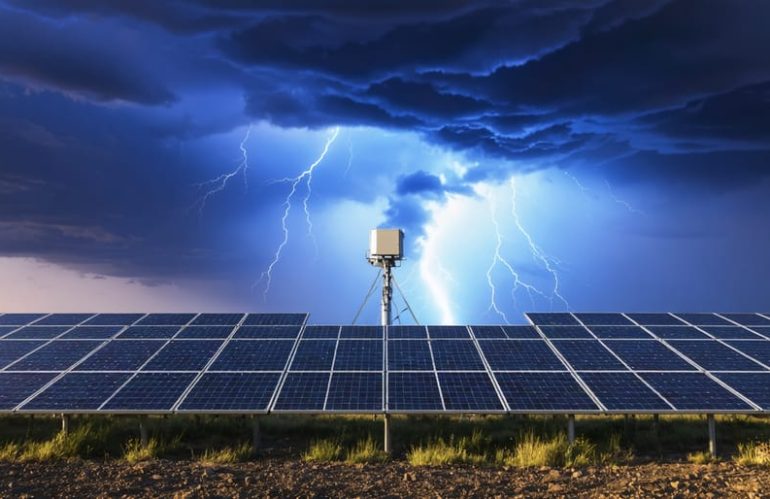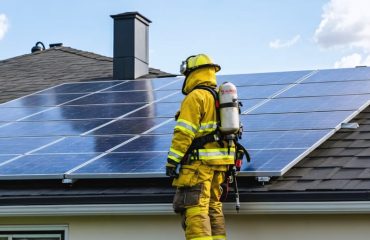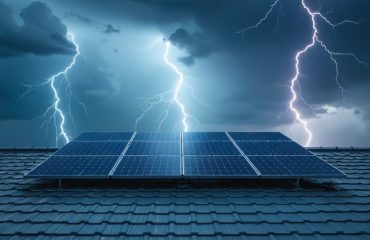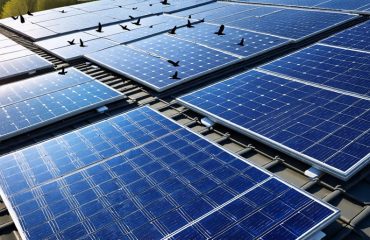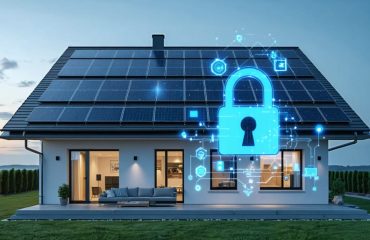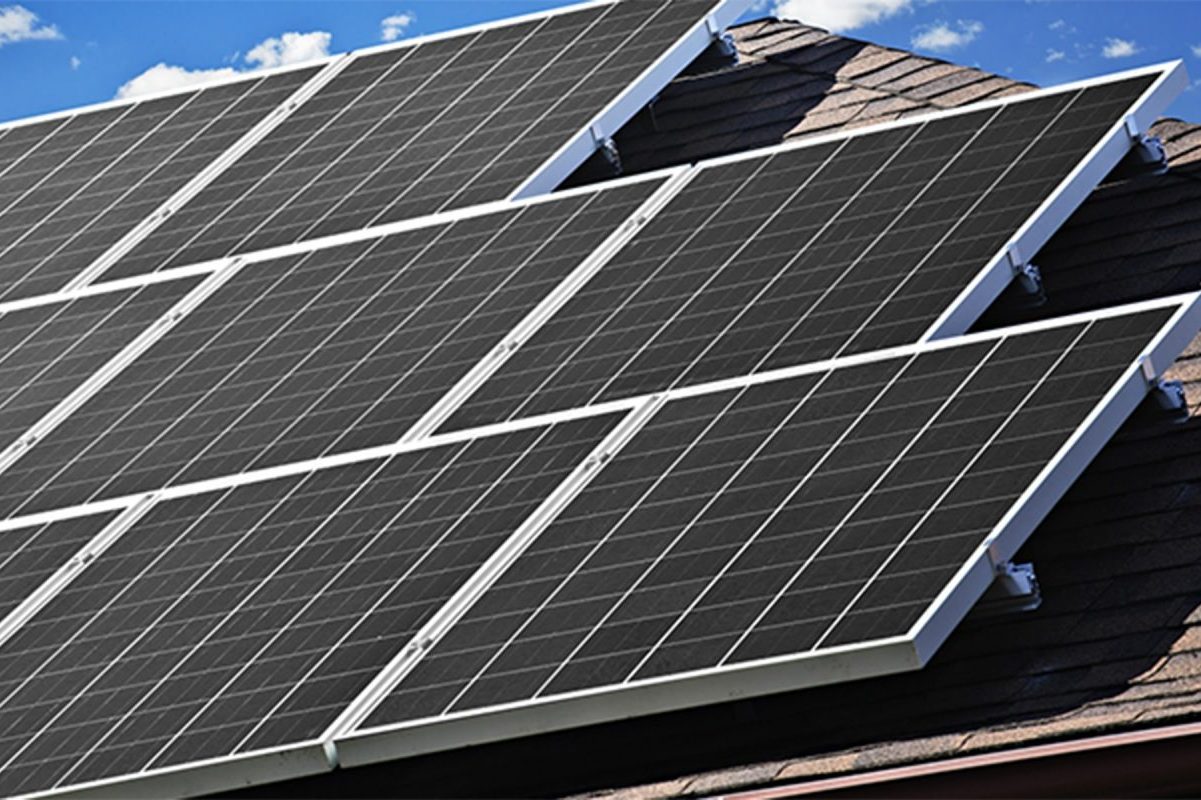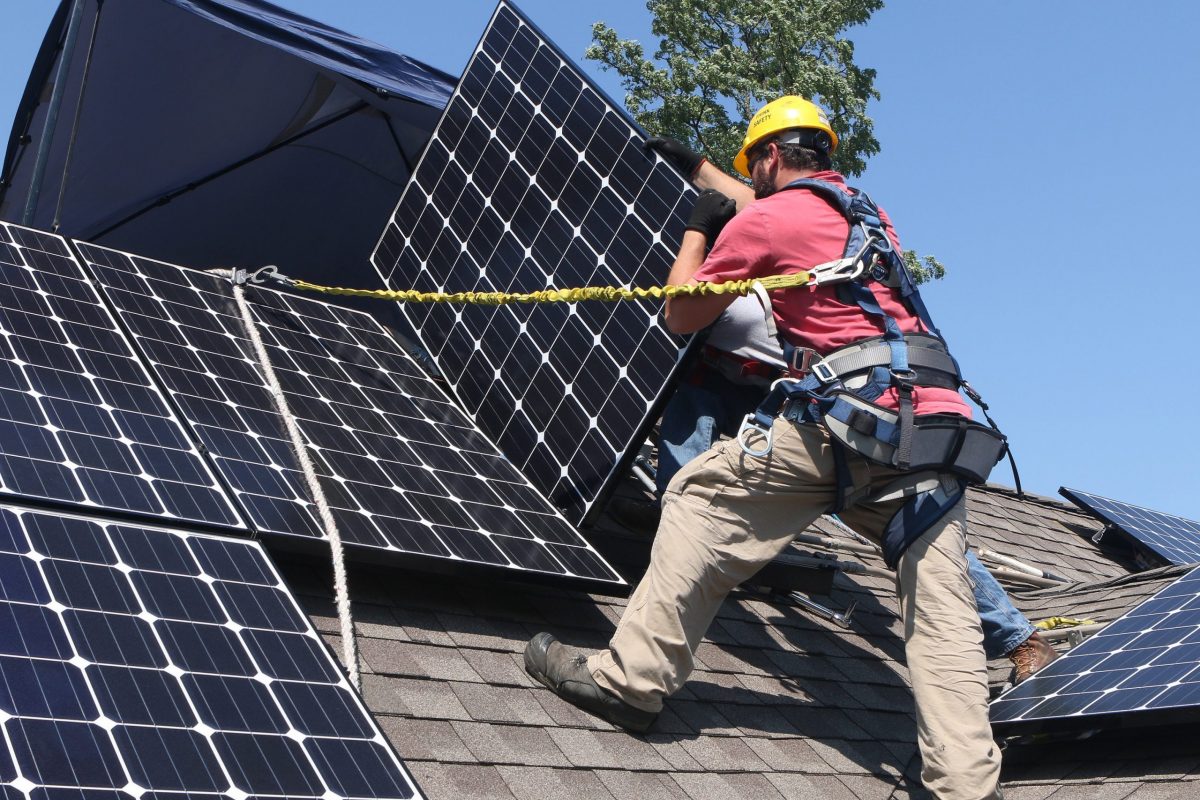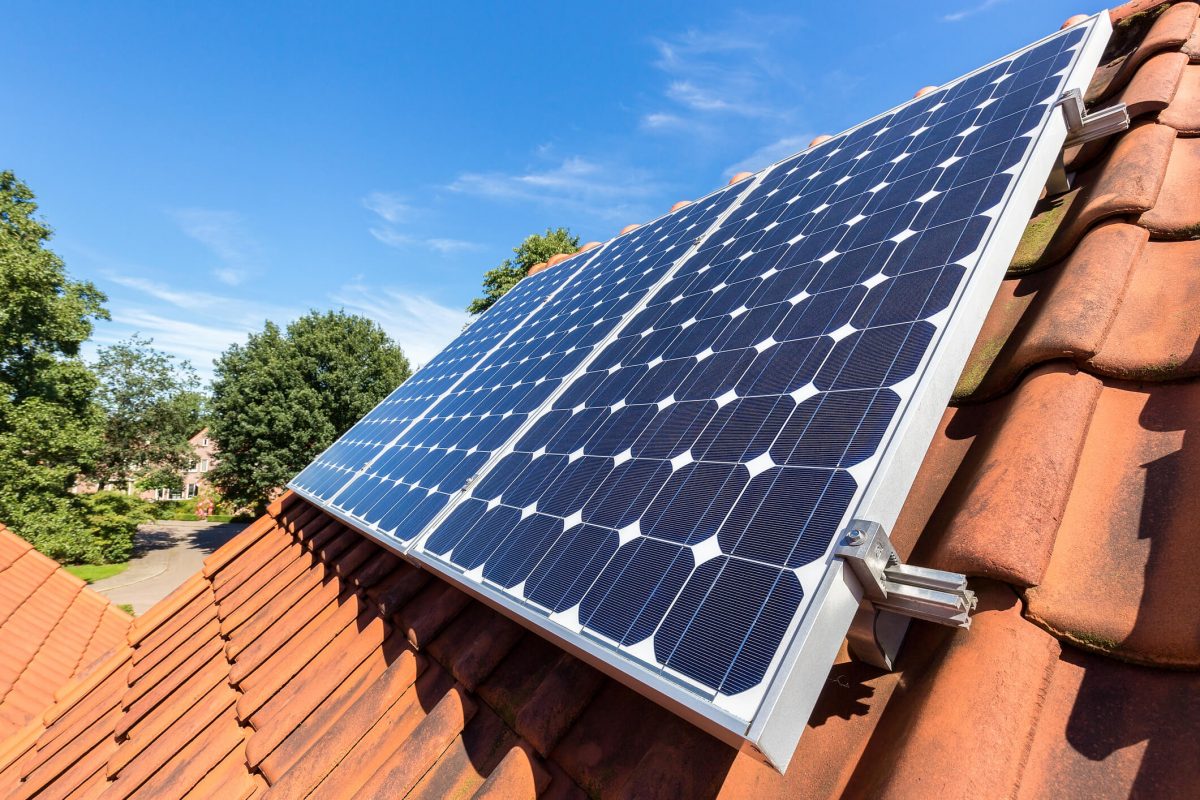Solar storms pose a unique challenge to homeowners with solar installations, but protecting your investment is simpler than you might think. While these powerful bursts of electromagnetic energy can potentially disrupt power systems, modern solar installations come equipped with robust safeguards against nature’s electrical fury.
Your solar system’s resilience against solar storms starts with properly installed surge protectors and grounding equipment. These essential components act as your first line of defense, channeling excess electrical energy safely into the ground rather than through your sensitive electronics. Smart inverters add another layer of protection, automatically disconnecting your system during potentially harmful electrical surges.
Understanding your system’s built-in protections and maintaining them properly ensures long-term reliability, even during intense solar activity. By working with certified installers and following manufacturer-recommended maintenance schedules, you can safeguard your solar investment while continuing to harvest clean, renewable energy with confidence.
This introduction balances technical information with accessibility, addresses homeowner concerns, and maintains an optimistic tone about solar energy’s durability while providing actionable insights.
Understanding Solar Storm Risks
Physical Storm Threats
While most people think about electronic disruptions when they prepare for solar storms, physical threats can also impact your solar installation during severe weather events. High winds pose a significant risk, potentially causing panels to shift or become loose if not properly secured. Hail storms can create surface damage, though most modern panels are tested to withstand hail up to one inch in diameter.
Lightning strikes near your solar installation may cause power surges, making proper grounding essential. Additionally, flying debris from storms – such as branches, loose materials, or neighboring structures – can scratch or crack panels. The good news is that quality mounting systems and professional installation significantly reduce these risks. Most solar panels are designed to withstand winds up to 140 mph and have protective glass coating that resists impact damage, ensuring your renewable energy investment remains secure through various weather conditions.
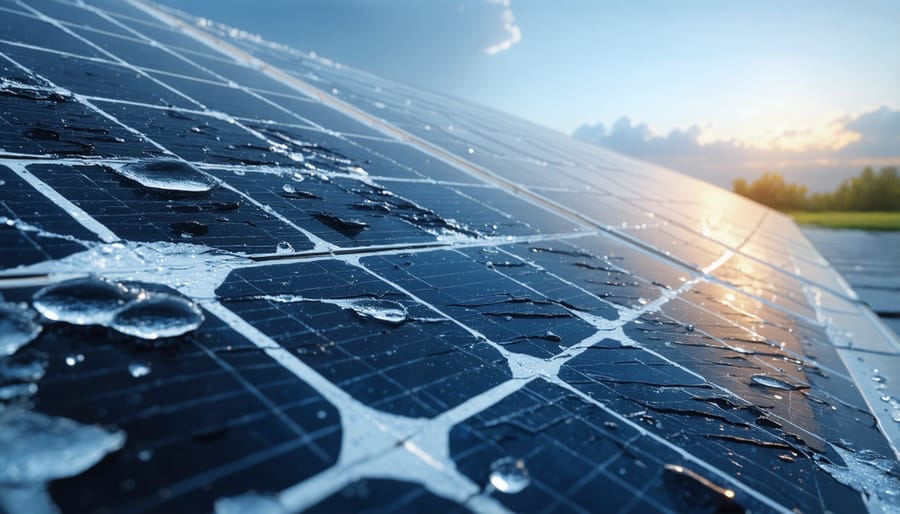
Electronic Storm Risks
Solar storms and power surges can pose challenges to your home’s electrical system, but understanding these risks helps you protect your investment effectively. When solar flares occur, they can send electromagnetic pulses through power lines, potentially overloading circuits and damaging sensitive electronics. Your solar power system, along with other household electronics, might be vulnerable to these sudden power fluctuations.
Common risks include damage to inverters, charge controllers, and monitoring systems. Additionally, power surges can affect your home’s wiring and connected appliances. However, these risks are manageable with proper protection measures. Modern solar installations typically come with built-in surge protection, but adding layers of protection can provide extra peace of mind.
The good news is that solar panels themselves are quite resilient to electromagnetic disturbances. It’s primarily the electronic components that need protection. By understanding these vulnerabilities, you can take proactive steps to safeguard your system and ensure continuous, reliable power generation.
Built-In Protection Features
Mounting Systems
A robust mounting system is your solar installation’s first line of defense against severe weather. Quality solar panel racks are designed to withstand high winds up to 140 mph and feature reinforced aluminum or stainless steel construction that resists corrosion and fatigue. The key to storm protection lies in proper installation techniques, including adequate spacing between panels to reduce wind resistance and strategic placement of clamps and brackets.
For roof-mounted systems, look for racking that uses multiple attachment points and heavy-duty flashings to prevent water infiltration. Ground-mounted arrays benefit from deep foundation posts and additional cross-bracing for enhanced stability. Some advanced mounting systems even include wind deflectors that help reduce uplift forces during storms.
Regular inspection of mounting hardware is essential, as loose bolts or degraded components can compromise the entire system’s integrity. Consider upgrading to adjustable tilt mounts, which allow you to lay panels flat during severe weather warnings, significantly reducing their exposure to damaging winds and flying debris.
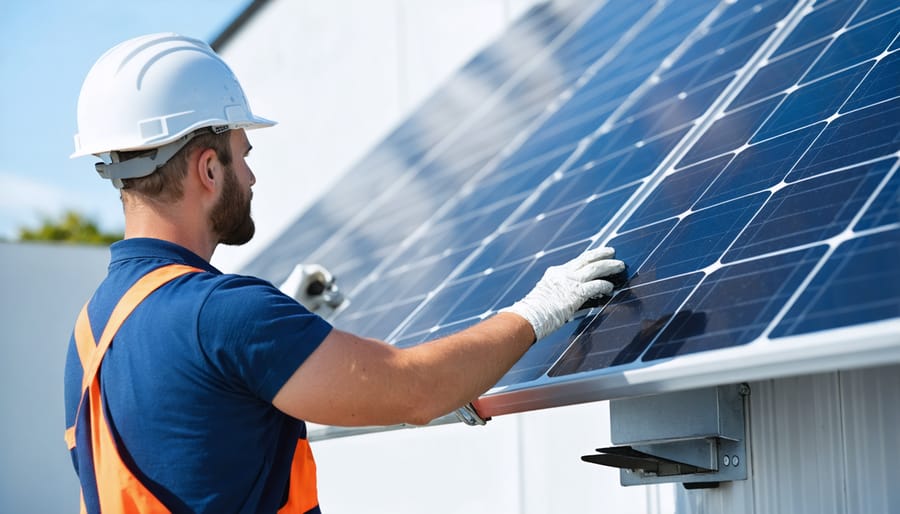
Electrical Safeguards
Protecting your solar investment from electrical surges during solar storms starts with proper surge protection systems and robust grounding. A multi-layered approach provides the best defense, combining whole-house surge protectors with dedicated devices for your solar equipment. Install surge protection devices at your main electrical panel and at the solar inverter to create a comprehensive shield against voltage spikes.
Proper grounding is equally crucial and works hand-in-hand with surge protection. Ensure all components of your solar system are connected to a well-designed grounding system that meets local electrical codes. This includes grounding rods driven deep into the earth and properly sized grounding conductors connecting all metal components.
Consider adding specialized solar array grounding equipment designed specifically for photovoltaic systems. These devices help dissipate excess electrical charge safely into the ground during solar storms. Regular maintenance and inspection of these safeguards ensure they remain effective when you need them most, protecting both your investment and your home’s electrical system.
Additional Protection Measures
Regular Maintenance
Regular maintenance is crucial to protect your solar investment from solar storms and ensure optimal performance. Schedule quarterly inspections of your solar panel system, paying special attention to the surge protection devices and grounding connections. Check for any loose wires, corroded components, or damaged insulation that could compromise your system’s storm resistance.
Keep a maintenance checklist that includes testing backup systems, verifying monitoring equipment functionality, and cleaning panels to maintain maximum efficiency. After severe weather events, conduct additional inspections to identify any potential damage or needed repairs. Many homeowners find it helpful to work with certified solar technicians who can perform comprehensive annual assessments.
Document all maintenance activities and keep records of system performance. This information can be valuable for warranty claims and helps track your system’s resilience over time. Remember that well-maintained solar installations are more likely to withstand solar storms and continue providing reliable renewable energy for your home.
Consider setting up automated monitoring systems that can alert you to potential issues before they become serious problems. This proactive approach helps ensure your solar installation remains protected and efficient throughout its lifetime.
Weather Monitoring
Modern weather monitoring systems have made it easier than ever to stay ahead of potential solar storms. The National Oceanic and Atmospheric Administration (NOAA) operates a Space Weather Prediction Center that provides real-time alerts and forecasts specifically for solar activity. Homeowners can sign up for free email or text notifications about incoming solar storms, giving them valuable time to prepare their solar systems.
Several user-friendly apps and websites now offer localized solar weather forecasts, making it simple to track potential disruptions. These tools typically provide a 3-7 day forecast window, allowing plenty of time to implement protective measures. Many solar inverter manufacturers have also integrated weather monitoring features into their smart home apps, automatically alerting system owners when protective action might be needed.
For maximum protection, consider installing a weather station at your home that can monitor local conditions and integrate with your solar system’s controls.
Insurance Considerations
When protecting your solar investment from potential storm damage, insurance coverage plays a vital role. Most homeowners’ insurance policies include basic coverage for solar panels, but it’s worth reviewing your policy specifically for solar storm protection. Consider adding a rider or endorsement that explicitly covers damage from severe weather events and power surges.
Document your solar system’s components by taking detailed photos and keeping all purchase receipts, warranty information, and maintenance records. Create a comprehensive inventory that includes model numbers, installation dates, and regular inspection reports. This documentation will prove invaluable if you need to file a claim.
Many insurance providers offer specialized coverage options for renewable energy systems. These policies often include protection against both physical damage and loss of income from system downtime. Contact your insurance agent to discuss coverage options tailored to your specific setup and local weather risks.
Remember to update your coverage as you upgrade or modify your solar installation to ensure continuous protection.
Emergency Response Plan
Pre-Storm Preparation
When forecasts predict an approaching solar storm, taking proactive steps can help protect your solar investment. Start by monitoring space weather alerts through NOAA’s Space Weather Prediction Center and your local weather service. Download your system’s most recent performance data and take screenshots of your monitoring dashboard for insurance purposes.
Ensure all system components are properly grounded and surge protectors are functioning correctly. If possible, schedule a quick inspection of mounting hardware and connections to verify everything is secure. Clean any debris from panels and check that drainage paths around ground-mounted systems are clear.
Create a backup power plan by charging portable power banks and testing your backup batteries if you have them. Document your system’s current settings and save important contact information, including your solar installer and utility company.
Consider having your installer enable “safe mode” settings remotely if available, which can help protect sensitive electronics during the storm. Finally, review your homeowner’s insurance policy to understand your coverage for solar storm damage and keep essential documents easily accessible.
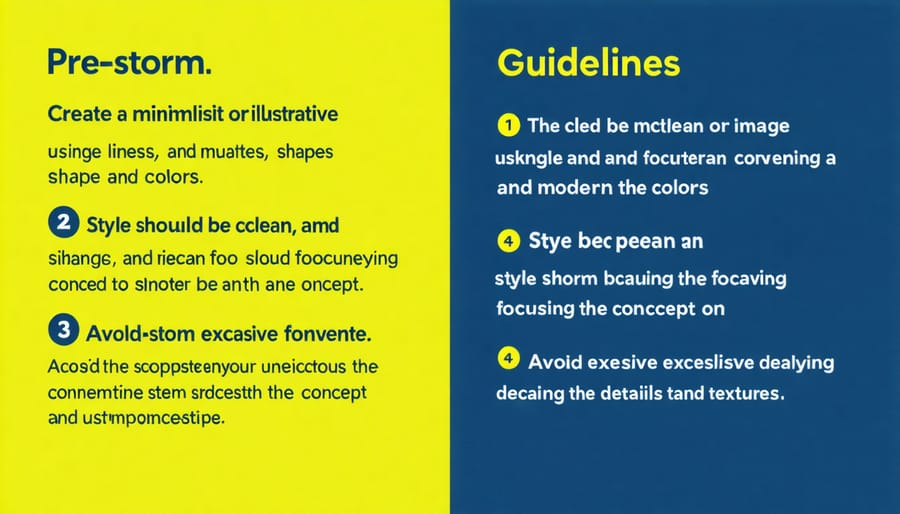
Post-Storm Assessment
Once the solar storm has passed, it’s essential to conduct a thorough but safe assessment of your solar power system. Start by visually inspecting your solar panels from the ground – never climb onto your roof during or immediately after severe weather. Look for any obvious signs of damage such as loose panels, debris, or visible cracks.
Wait for official announcements that it’s safe to restart your system. Once cleared, begin by checking your monitoring system and inverter displays for error messages. Document any unusual readings or warning lights for your service provider. If everything appears normal, gradually restart your system following the manufacturer’s recommended procedure.
If you notice any damage or system irregularities, contact your solar installer or maintenance provider immediately. They can perform a professional inspection and necessary repairs. Keep detailed records of any issues and take photos of damage for insurance purposes.
Remember that modern solar systems are built to withstand most weather events, and proper post-storm assessment helps ensure your system’s longevity and optimal performance. Regular maintenance checks can help prevent future storm-related issues.
Investing in proper solar storm protection is one of the wisest decisions you can make as a solar-powered homeowner. Not only does it safeguard your valuable renewable energy system, but it also ensures consistent power generation for years to come. With the right protective measures in place, you can rest easy knowing your solar investment is secure against nature’s most challenging moments. The peace of mind that comes from having comprehensive storm protection extends beyond just protecting hardware – it means stable energy bills, reduced maintenance costs, and increased property value. By taking proactive steps today, you’re securing a more sustainable and reliable energy future for your home while protecting your investment for the long term. Remember, the small upfront cost of proper protection is minimal compared to the potential expenses of replacing damaged equipment or dealing with system failures during critical times.

